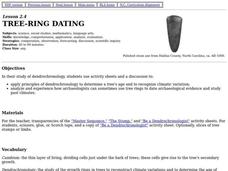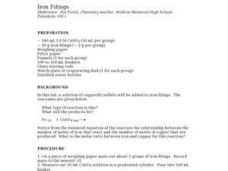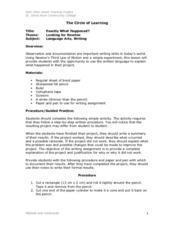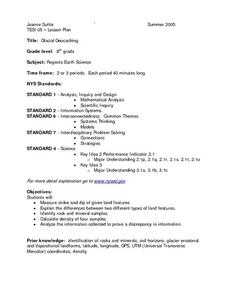Curated OER
Graphs
Students list their favorite cars and create graphs of their favorites. Students determine how the graphs would change as their choices change.
Curated OER
Organic Materials in an Aquatic Ecosystem
Pupils evaluate the relationship between oxygen levels and the amount of organic matter in an aquatic ecosystem. They explain the relationship between oxygen levels, bacteria and the breakdown of organic matter using an indicator solution.
Curated OER
Effects of Nitrate and Phosphate Changes on the Growth of Algae
Students determine the effects of an increase of the amount of nitrate and phosphate levels on the growth of algae. the development of a hypothesis is encouraged and students proceed to a conclusion based on their results.
Curated OER
Making a Mace
Students make a mace as a symbol of the legislatures authority to make laws.
Curated OER
Causal Patterns in Density Phenomena
Pupils realize that density exists. They develop a mental model of density-to realize that something is going on that they cannot see to account for differences between materials.
Curated OER
Tree-ring Dating
Middle schoolers complete activity sheets and participate in discussions while they study dendrochronology. They determine a tree's age and recognize how the climate varied over time.
Curated OER
Organic Matter in Soils
Students examine soil samples for the presence of organic matter. They determine which soil sample from their area contains the highest amount of organic matter.
Curated OER
Nature's Air Conditioner
Students observe the process of transpiration in leaves. They measure how much water a leaf gives off in a 24-hour period, calculate the volume, and answer discussion questions.
Curated OER
Cancer Warrior
Students perform an experiment to determine how different salt concentrations affect the liver's ability to break down toxic hydrogen peroxide. They record and average their data which is then graphed.
Curated OER
Different Types of Orange Juice Contain the Same Amounts of Vitamin C?
Students measure and compare the amount of vitamin C in orange juice samples. They discover the effects of different factors on the concentration of vitamin C. They participate in an experiment to test the orange juice.
Curated OER
How Big is a Molecule?
Students estimate the size of a molecule of oleic acid. They conduct an experiment using chalk dust, water, and oleic acid, solve various calculations, and answer discussion questions.
Curated OER
TE Activity: A Merry-Go-Round for Dirty Air
Students observe a simulation of a cyclone to examine a method of pollutant recovery in cleaning industrial air pollution. They examine how engineers develop technology to reduce air pollution and determine percentages for technology...
Curated OER
Iron Filings
Young scholars conduct an experiment in which a solution of copper(II) sulfate is added to iron filings. They write and balance the equation for the reaction that occurs and calculate the amount of iron that reacted and the percent yield...
Curated OER
Spectrophotometry Lab
Students use a machine called a spectrophotometer to determine how much light is absorbed by certain substances. Students record the absorbance and the % of light transmitted for different color solutions, graph their results, and then...
Curated OER
Colored H2 Balloon Explosions
Students perform an experiment in which they put different types of salts in a balloon, fill it with hydrogen gas, and ignite it. The electrons in the salt molecules are excited by the heat and release energy in the form of light. ...
Curated OER
The Circle of Learning
Students review Newton's Third Law of Motion and participate in an experiment. After the experiment, they use their notes to write a scientific summary of what happened during the project. They present their project to the class and...
Curated OER
A Cosmic Cafeteria
Students indentify and differentiate between transit and surface food systems. Students measure energy that is released by various foods. Students compare and contrast cooking with solar energy on earth and what they might have learned...
Curated OER
Glacial Geocaching
Eighth graders measure strike and dip of given land features and explain the difference between them. They also look at rock and mineral samples for indentification, along with calculating the density. Finally, information is analyzed...
Curated OER
Density
Students work with a partner to record observations on various materials. Working together, they calculate the mass and volume of each material and then combine them and shake them for a period of time. In their journals, they record...
Curated OER
Is It Safe To Go In?
Students examine acceptable levels of toxins in swimming areas. Working in groups of four, students dilute a salt or sugar solution to 1 part per 1,000,000 (ppm) solution. Students taste test their diluted liquids and record at which...
Curated OER
THE SPREAD OF AIDS
Learners perform a hands-on activity in which they simulate the spread of a disease such as aids. One student with unknowingly be the "carrier" of the infection and Students witness how fast it can spread.
Curated OER
Selecting Soil Organisms in Compost
Students conduct an experiment to demonstrate that many of the enzyme systems needed to break down society's wastes exist in nature among the decomposers in a compost pile. They culture compost bacteria on starch agar to examine the...
Curated OER
Selecting Soil Organisms in Compost
Students demonstrate that many of the enzyme systems needed to break down--and therefore clean up-society's wastes already exist in nature among the decomposers. They select the best starch-munching organisms by altering the environment...
Curated OER
Am I Neutral? pH Properties in Soil
Middle schoolers participate in a science lab to determine the pH of three different soil samples. Students conduct an experiment by creating a question, a hypothesis and then an investigation of soil samples. Then they compare colors...
Other popular searches
- Cylinders
- Volume of a Cylinder
- Cylinder Surface Area
- Reading a Graduated Cylinder
- Volume of Cylinders
- Surface Area of Cylinders
- Cylinders Cones Spheres
- Graduated Cylinders
- Surface Area Volume Cylinder
- Cylinder Surface Area Nets
- Cylinder 3 D Shapes
- Volume Cylinder

























